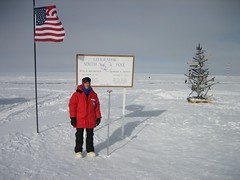
Oregon State University oceanographer Kelly Falkner’s work has taken her all the way to the North Pole and back, and her work has been so impactful that she even has a glacier named after her. But now Falkner is taking on a new challenge as she leaves the university to take a leadership position with the National Science Foundation, where she will be the new deputy head of the Office of Polar Programs.
A professor in OSU’s College of Oceanic and Atmospheric Sciences, Falkner will begin her new role with NSF on Jan. 3, and joins a long list of other OSU faculty members who have been elevated to important government leadership positions. “It wasn’t an easy decision, because I’ve had a great career at OSU and I’ll miss my excellent colleagues, the students, and the supportive staff here,” Falkner said. “But I couldn’t pass up this opportunity to take my polar interests into broader community service.”

In 2007, she took a two-year leave from OSU to serve as the agency’s first program director for integrated Antarctic research. Her stint was so successful, her NSF colleagues named a glacier after her. “Falkner Glacier” is an east-flowing valley glacier stretching four miles long through the Mountaineer Range in Victoria Land. In her new role, Falkner will join the NSF Office of Polar Programs, which manages and initiates the agency’s funding for basic research and operational support in the Arctic and Antarctic regions. The office supports individual investigators, as well as research teams and United States participation in multi-national projects.
Falkner isn’t the only OSU professor who has earned a leadership position with a federal agency. Zoologist Jane Lubchenco was named administrator of the National Oceanic and Atmospheric Administration last year. Among other OSU professors in leadership positions are:
- Mark Abbott, dean of the College of Oceanic and Atmospheric Sciences (COAS) is a member of the National Science Board;
- Michael Freilich, a COAS professor, is director of the Earth Sciences Division at NASA;
- Timothy J. Cowles, COAS professor, is program director for the Ocean Observatories Initiative, the National Science Foundation’s signature research project on climate change;
- Jim McManus, COAS professor, recently served as associate program director of the chemical oceanography program at the National Science Foundation;
- Mark Hixon, a professor of marine biology, chaired the federal advisory committee that helped produce the framework for the national system of marine protected areas;
- Geosciences professor Peter Clark and Philip Mote, who directs the Oregon Climate Change Research Institute at OSU, have been named lead authors for the Intergovernmental Panel on Climate Change Fifth Assessment Report. It will be the much-anticipated follow-up to the IPCC Fourth Assessment Report, which garnered a share of the Nobel Peace Prize in 2007;
- Dean of the College of Veterinary Medicine Cyril Clarke is a member of the USDA’s National Agricultural Research, Extension, Education, and Economics Advisory Board.
- COAS professor Adam Schultz spent some time on loan to the NSF, where he served as program director for Marine Geology and Geophysics, overseeing the Ridge 2000 program, which explored deep-ocean ridges.
The stellar work our faculty does goes a long way to attracting high-achieving students to Oregon State. University Honors College sophomore Sam Kelly-Quattrochi doesn’t know what his major will be, but was initially impressed by the quality of OSU’s marine biology program, and the research opportunities available to undergraduate students at OSU’s Hatfield Marine Science Center.
Honors College sophomore Emily Pickering became the first freshman at OSU to accompany Mark Hixon and his crew to Lee Stocking Island, where she helped survey lionfish and created her ownproject on lionfish prey preference and digestion. Pickering also blogged about her experiences there.
Master’s student Cody Beedlow, following in the footsteps of his adviser, Peter Clark, is providing key data on glacial retreat in Oregon. Every month in the spring and summer, Beedlow treks to Collier with 65 pounds of equipment in tow and the intention to measure Collier’s glacial melt over time. Over the past year, he’s found that the glacier has decreased by more than 20 percent from its size in the late 1980s. He hopes that when he graduates, someone else takes on the work he’s doing to measure Collier.
OSU alums also go on to make a difference in government. Marine resource management alum Laura Anderson owns and operates the popular Local Ocean, a fish market and restaurant in Newport, Ore. It’s the kind of place where people frequently leave feeling like they’ve had the best seafood in their lives. But Anderson also keeps a keen eye on issues revolving around healthy fisheries. She volunteers as an advocate for the fishing industry in Oregon and beyond, making trips to Washington, D.C. to testify before Congress.
Alum Gail Kimbell, who holds a master degree in forest engineering from the OSU College of Forestry, was named the first woman to lead the U.S. Forest Service. After graduating from OSU with an M.F. in forest engineering in 1982, Kimbell began her career in the federal government as a forester with the Bureau of Land Management in Medford, Ore. Kimbell held the position until last year.






